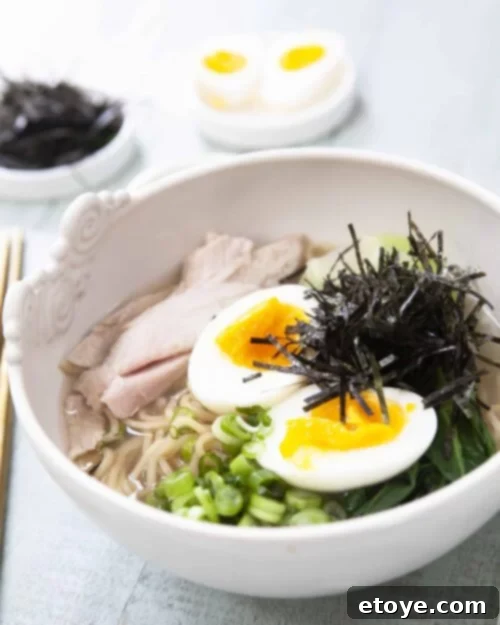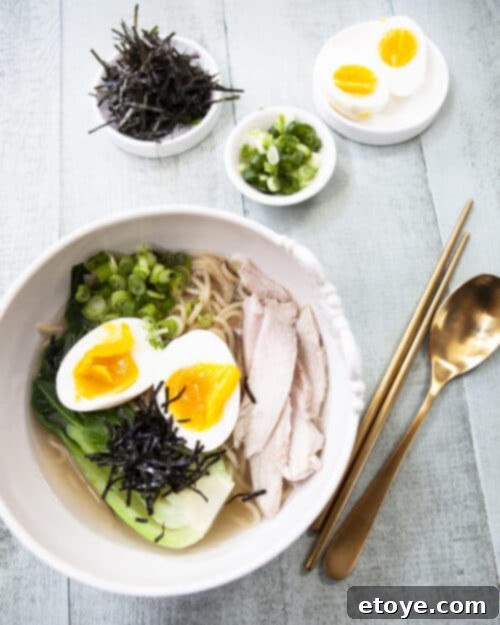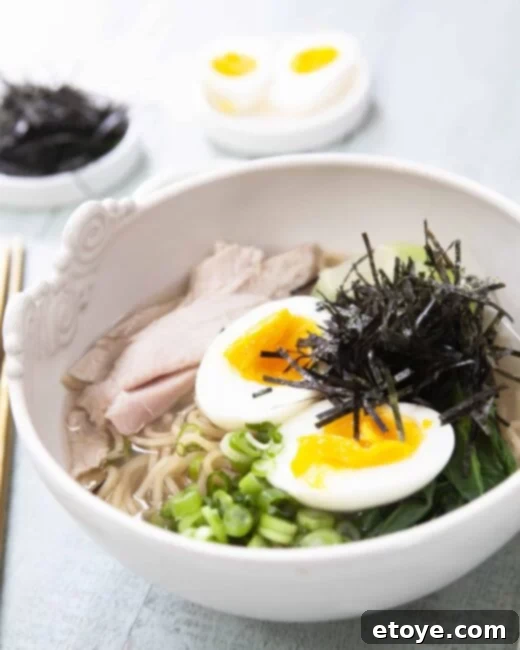From Feast to Flavor: The Ultimate Leftover Turkey Miso Ramen Recipe
There’s a universal truth in many households after a grand holiday feast: the battle for the turkey bones. While others might vie for the last slice of pie, my family understands that these bones are a golden ticket, a culinary cornerstone to countless delicious meals to come. Far from being mere leftovers, they hold the secret to transforming ordinary ingredients into extraordinary dishes.
My absolute favorite way to honor these precious bones is by transforming them into a rich, deeply flavorful broth for a Japanese-inspired Miso Ramen. This creamy, comforting noodle soup is surprisingly simple to prepare, especially when you harness the efficiency of a pressure cooker. And here’s the best part: this ramen tastes absolutely nothing like your holiday meal, offering a delightful and refreshing change of pace!

Transforming leftover turkey bones into a delicious Miso Ramen is a culinary adventure you won’t regret!
Giving New Life to Leftover Turkey: Beyond the Sandwich

Our culinary philosophy is rooted in a simple yet powerful mission: to significantly reduce food waste, especially during the festive holiday season when families gather for those magnificent feasts. The sheer volume of food often prepared can lead to an abundance of leftovers, and while a reheated plate might satisfy once, it rarely holds the same appeal night after night.
The true genius of repurposing leftover turkey lies in an essential secret: ensuring the new meal tastes completely distinct from your original holiday dinner. Let’s be honest – holiday leftovers, no matter how delicious initially, rarely taste as good the second or third time around. Nobody wants to relive the same meal four nights in a row, leading to boredom and, ultimately, food waste. By creating a dish with an entirely different flavor profile, you reignite enthusiasm for your leftovers, turning them into exciting new culinary experiences.
This approach isn’t just about culinary creativity; it’s also about sustainability and smart budgeting. Every part of the turkey, from the succulent meat to the nutrient-rich bones, can contribute to another fantastic meal, reducing what ends up in the bin. Embracing this philosophy allows you to extend the joy of your holiday feast for days, even weeks, providing wholesome and inventive meals without the hassle of starting from scratch.
Also in this “Giving New Life to Leftover Turkey” series, discover more innovative recipes:
- Vietnamese Turkey Pho Buddha Bowl: A light, aromatic, and herb-filled noodle soup, perfect for a refreshing post-holiday meal.
- Halal Cart-Style Turkey & Rice: Transport your taste buds to the streets with this savory, spiced turkey served over rice with a tangy white sauce.
- Tikka Masala Turkey: A rich and creamy Indian-inspired curry that completely transforms the flavor and texture of your leftover turkey.
- Turkey Gumbo: A hearty, flavorful stew bursting with Creole spices, perfect for a warming meal on a cold day.
- Thai Basil Turkey Wraps: Fresh, zesty, and vibrant wraps offering a light yet satisfying alternative to heavier holiday fare.

Expert Tips for Making Flavorful Broth from Thanksgiving Turkey Bones
Creating a stellar broth from your turkey bones is an art, but with a few key tips, it becomes an incredibly rewarding and straightforward process. The foundation of any great ramen or soup lies in its broth, and your leftover turkey bones are perfectly positioned to deliver that rich, complex base.
- **Utilize the Forgotten Treasures:** Always save the turkey neck and giblets from the package for your stock. These often-overlooked components are packed with collagen and flavor, contributing significantly to a rich and gelatinous broth. They release deep, savory notes during simmering that are essential for a robust stock.
- **The Liver Exclusion Rule:** Crucially, do NOT include the liver in your stock. While giblets are great, boiling the liver will impart an unpleasantly gritty texture and a bitter taste to your entire broth, compromising the clean flavor you’re aiming for. It’s best to simply discard the liver or, if you’re feeling generous, roast it separately as a treat for your beloved dog or cat.
- **Neutralizing the “Holiday Taste” for Asian Broths:** If you’re aiming for an Asian-style broth, like our Miso Ramen, it’s vital to avoid any residual Thanksgiving flavors. Most turkeys are seasoned heavily with herbs like sage, thyme, and rosemary before roasting. While delicious for the holiday meal, these seasonings will make your new broth taste like a repeat of the past. To prevent this, try not to include any turkey skin in the pot, as it often carries the strongest seasoning. Additionally, focus solely on using the bones from the body, rather than wing tips, which can also hold onto seasoning. For an extra measure of neutrality, you can even give the bones a quick rinse before adding them to the pot, ensuring any lingering herbs or seasonings are washed off, allowing the true turkey flavor to shine through, unadulterated.
- **Choose Your Cooking Method:** The beauty of making bone broth is its versatility in preparation. You can achieve excellent results using a traditional stovetop method, letting it gently simmer for hours. For a hands-off approach, a slow cooker works wonderfully, allowing flavors to meld over an extended period. However, for speed and efficiency, an electric pressure cooker is an absolute game-changer, dramatically cutting down the cooking time while extracting maximum flavor and collagen. Each method yields a slightly different depth of flavor and texture, so choose the one that best fits your schedule and preferences.
- **Our Flavor Shortcut:** In the next section, we’ll reveal a brilliant shortcut to supplement your broth’s flavor and significantly cut down on simmering time, ensuring a delicious outcome even on busy days.
The result of these careful steps? A truly delicious, mouthwatering broth that boasts all the complex flavors extracted from those roasted turkey bones. It’s a testament to the fact that nothing goes to waste in a truly resourceful kitchen. And if you happen to not have roasted turkey bones on hand, don’t worry – a high-quality chicken stock can easily step in as a flavorful substitute!
Mastering the Flavor of Homemade Ramen Broth
Many home cooks are intimidated by the idea of making ramen broth from scratch, often believing it to be an overly complex endeavor. However, I’m here to let you in on a culinary secret: crafting a delicious, creamy ramen broth at home is surprisingly straightforward! With a few key ingredients and our turkey bone broth base, you’ll be enjoying restaurant-quality ramen in your own kitchen.
To create this rich and flavorful miso ramen broth, you’ll need the following ingredients:
- 2-3 pounds roasted turkey bones (as prepared in the previous section)
- 8 cups water (to create the initial turkey broth)
- 2 teaspoons instant dashi
- 1 tablespoon soy sauce
- 4 tablespoons miso paste
If some of these essential ingredients aren’t already staples in your pantry, it’s highly recommended to add them to your next grocery list. Soy sauce, instant dashi, and miso paste are not just for ramen; they are incredibly versatile power-ups for a multitude of leftover recipes, imparting a significant flavor boost and adding depth to various dishes. They store well and will become invaluable assets in your kitchen for creating quick, flavor-packed meals.
Let’s dive a little deeper into why these ingredients are so crucial for an authentic and delicious ramen broth:
- **Roasted Turkey Bones & Water:** These form the foundational, nutrient-rich liquid. The slow extraction of gelatin and flavor from the bones creates a deeply savory and satisfying base, a true testament to our “no waste” philosophy.
- **Instant Dashi:** This is your secret weapon for instant umami. Dashi is a fundamental Japanese stock, traditionally made from kombu (dried kelp) and katsuobushi (dried bonito flakes). Instant dashi, often in granular form, provides that characteristic savory depth and marine essence without the long preparation, instantly elevating your turkey broth to a Japanese flavor profile. It’s the shortcut mentioned earlier that makes your broth taste like it simmered for hours, even if it didn’t.
- **Soy Sauce:** Beyond just saltiness, soy sauce adds a layer of complex umami and a subtle fermented tang. It balances the flavors and contributes to the rich brown hue of the broth.
- **Miso Paste:** This fermented soybean paste is the heart of miso ramen. It provides a creamy texture, a profoundly savory and slightly sweet flavor, and a wealth of probiotics (which is why we add it off the heat). Different types of miso (white, yellow, red) offer varying intensities; white or yellow miso typically provides a milder, sweeter, and creamier profile, perfect for a balanced ramen. It’s essential to whisk it in at the very end, off the direct heat, to preserve its delicate flavor and beneficial enzymes.
With these powerhouse ingredients, you’ll be well on your way to crafting a homemade ramen that is both impressive and incredibly satisfying, proving that gourmet flavors are well within reach with a little planning and the right staples.

Customize your turkey ramen with whatever fresh ingredients you have available in your refrigerator!
Customize Your Ramen: Use What You Already Have!
One of the most enjoyable aspects of making homemade ramen, especially with leftovers, is the freedom to customize it with ingredients you already have on hand. It’s an excellent opportunity to “raid the refrigerator” and prevent food waste by incorporating all those lingering vegetables and proteins in your crisper drawer. This not only makes your meal unique but also ensures you’re getting a diverse range of nutrients and flavors.
For our turkey miso ramen, we chose to include vibrant baby bok choy, perfectly soft-boiled eggs, and freshly chopped green onions. However, the possibilities are truly endless. Imagine adding crisp sugar snap peas for a pop of sweetness and crunch, a handful of shredded cabbage for texture, or even a lone carrot that can be julienned into delicate strips. Other fantastic additions might include thinly sliced mushrooms (shiitake or cremini), corn kernels, bamboo shoots, or even a sprinkle of sesame seeds. Don’t hesitate to use it all! The goal is to create a bowl that is both delicious and efficient, utilizing every last edible bit.
Beyond vegetables, consider other protein additions. While our recipe features delicious leftover turkey meat, you could also add thinly sliced cooked chicken, pan-fried tofu, or even some shrimp for an extra boost. The beauty of ramen is its adaptability, allowing you to create a personalized, comforting bowl tailored to your pantry and preferences.
If you enjoyed this creative and flexible recipe, be sure to check out our Easy Beef Ramen Noodle Bowl recipe for another equally satisfying and customizable version!

Turkey Miso Ramen
Pin Recipe
Ingredients
Pressure Cooker Miso Ramen Broth
- 2-3 pounds roasted turkey bones (cleaned, without skin or liver)
- 8 cups water
- 2 teaspoons instant dashi granules
- 1 tablespoon soy sauce (low sodium preferred)
- 4 tablespoons miso paste (white or yellow variety recommended)
For the Ramen
- 1 pound fresh ramen noodles
- 8 ounces cooked sliced turkey meat
Optional Toppings (Raid the Refrigerator!)
- 4 large eggs
- 4 baby bok choy halved lengthwise
- 2 stalks green onion thinly sliced or chopped
- ¼ cup shredded nori (dried seaweed)
- Other fresh vegetables like spinach, corn, bean sprouts, or bamboo shoots
Instructions
- **Prepare the Turkey Bone Broth:** In your electric pressure cooker, carefully place the roasted turkey bones and pour in 8 cups of water. Ensure the bones are relatively clean of any skin or strong holiday seasonings, giving them a quick rinse if necessary. Secure the lid according to your appliance’s instructions and set it to cook on high pressure for 30 minutes. Once the cooking cycle is complete, allow the pressure to release naturally for about 10-15 minutes, then carefully quick-release any remaining pressure. Using a fine-meshed strainer or cheesecloth, thoroughly strain the broth into a clean pot or bowl, pressing gently on the bones to extract all the flavorful liquid. Discard the spent turkey bones. Return the rich broth to the pressure cooker pot or a saucepan and set it to “Keep Warm” on low heat while you prepare the remaining components.
- **Perfect Your Soft-Boiled Eggs:** While the turkey stock is cooking, it’s the ideal time to prepare your soft-boiled eggs, which will serve as a delightful ramen topping. Bring a large stockpot of water to a rolling boil. Take each egg and, using a needle or the very tip of a paring knife, carefully prick a small hole at the rounder, fatter end of the egg. This helps prevent cracking during cooking and makes peeling easier. Once the water is boiling vigorously, place the eggs inside a fine-meshed strainer and gently dunk them into the hot water a few times. This gradual acclimation to the heat helps prevent the shells from cracking from a sudden temperature change. Lower the eggs fully into the boiling water and cook them for exactly 6 minutes for a perfect jammy yolk. Immediately prepare a large bowl of iced water at the sink. When the 6 minutes are up, use the strainer to quickly remove the eggs from the boiling water and plunge them into the ice bath. This stops the cooking process immediately and facilitates easier peeling. Let them sit for a few minutes until cool enough to handle, then carefully peel them under cold running water. Once peeled, slice each egg cleanly in half. (Remember to keep the boiling water for the next steps!)
- **Blanch the Baby Bok Choy:** Return the same pot of water used for the eggs to a boil. Add the halved baby bok choy to the boiling water and cook for just 1 minute. This quick blanching will make the bok choy tender-crisp and vibrant green without overcooking it. Remove the bok choy with a strainer and set it aside. Again, keep the boiling water in the pot – we’ll use it one last time.
- **Cook the Ramen Noodles:** Bring the water back to a boil for the final time. Add the fresh ramen noodles to the vigorously boiling water and cook them according to the package instructions. Fresh ramen noodles typically cook very quickly, often in 1-2 minutes, so keep a close eye on them to prevent them from becoming mushy. Once cooked al dente, drain the noodles thoroughly (now you can discard the water!). Divide the hot noodles evenly among 4 large ramen bowls.
- **Finish the Broth:** With your broth kept warm in the pressure cooker or saucepan, turn the heat to “Saute” (or medium-low on a stovetop) to bring it to a gentle simmer. Stir in the instant dashi granules and the soy sauce, allowing them to dissolve and infuse their flavors into the turkey broth. Once the broth is hot and flavorful, turn OFF the heat completely. This step is crucial for incorporating the miso paste. Add the miso paste to the warm (but not boiling) broth and whisk it in thoroughly until it is completely dissolved and no clumps remain. It is very important to turn off the heat before adding miso, as high heat can “break” the miso, causing it to become gritty and diminishing its delicate flavor and beneficial enzymes.
- **Assemble and Serve Your Ramen:** Ladle the hot, rich miso turkey broth generously over the noodles in each of the four bowls. Arrange your prepared toppings artfully on top: place two egg halves, a few pieces of blanched baby bok choy, slices of your cooked leftover turkey meat, a sprinkle of fresh green onion, and some shredded nori on each bowl. Serve immediately and enjoy the comforting, deeply flavorful taste of your homemade Leftover Turkey Miso Ramen!

